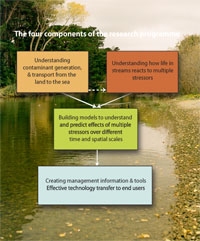Protecting our aquatic environments

“Environmental problems in our waterways associated with land-use change, or land-use intensification, are rarely caused by a single factor,” says NIWA’s Dr Malcolm Green, leader of a research programme aimed at protecting aquatic environments.
“Changes such as conversion of forestry to pasture, or increased irrigation take, can fundamentally affect life in our streams, rivers, lakes, and estuaries,” says Malcolm. “Water flow and temperature, and levels of sediments and nutrients, can all change. So we are approaching the issue by looking at how a number of factors, or ‘multiple stressors’, combine to affect life in our waterways.”
The programme – ‘Effects-based protection and management of aquatic ecosystems’ – is funded by the Foundation for Research, Science & Technology, and is providing water resource managers with new tools to help predict and manage water contaminants. These tools will encourage more rigorous ‘effects-based management’ – making management decisions armed with better knowledge of the likely environmental effects over time.
